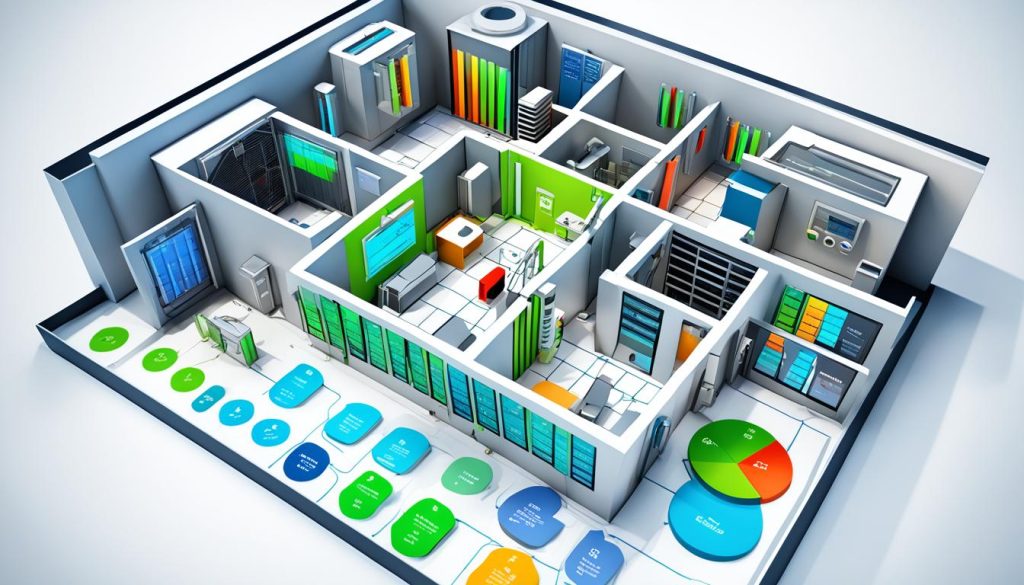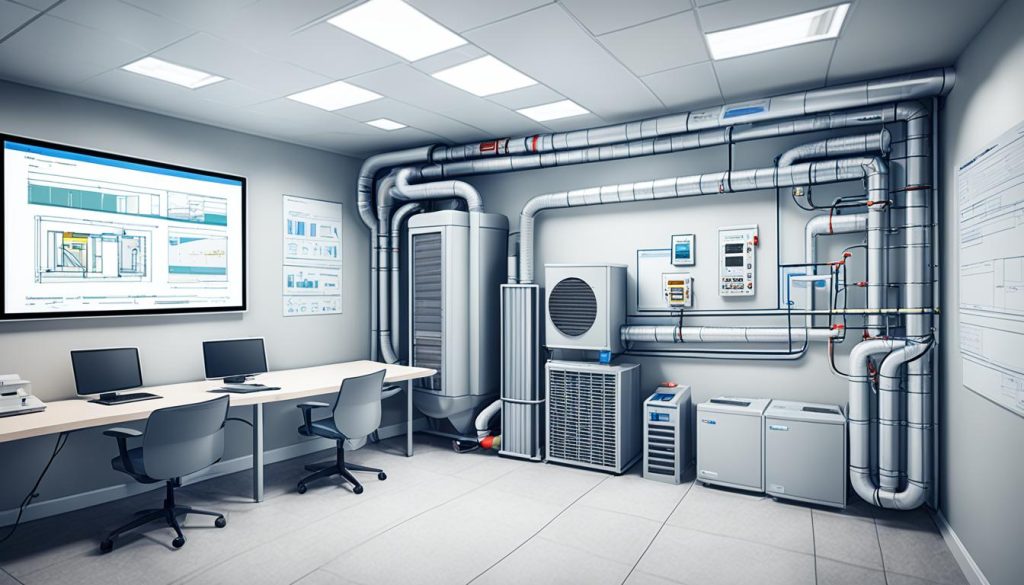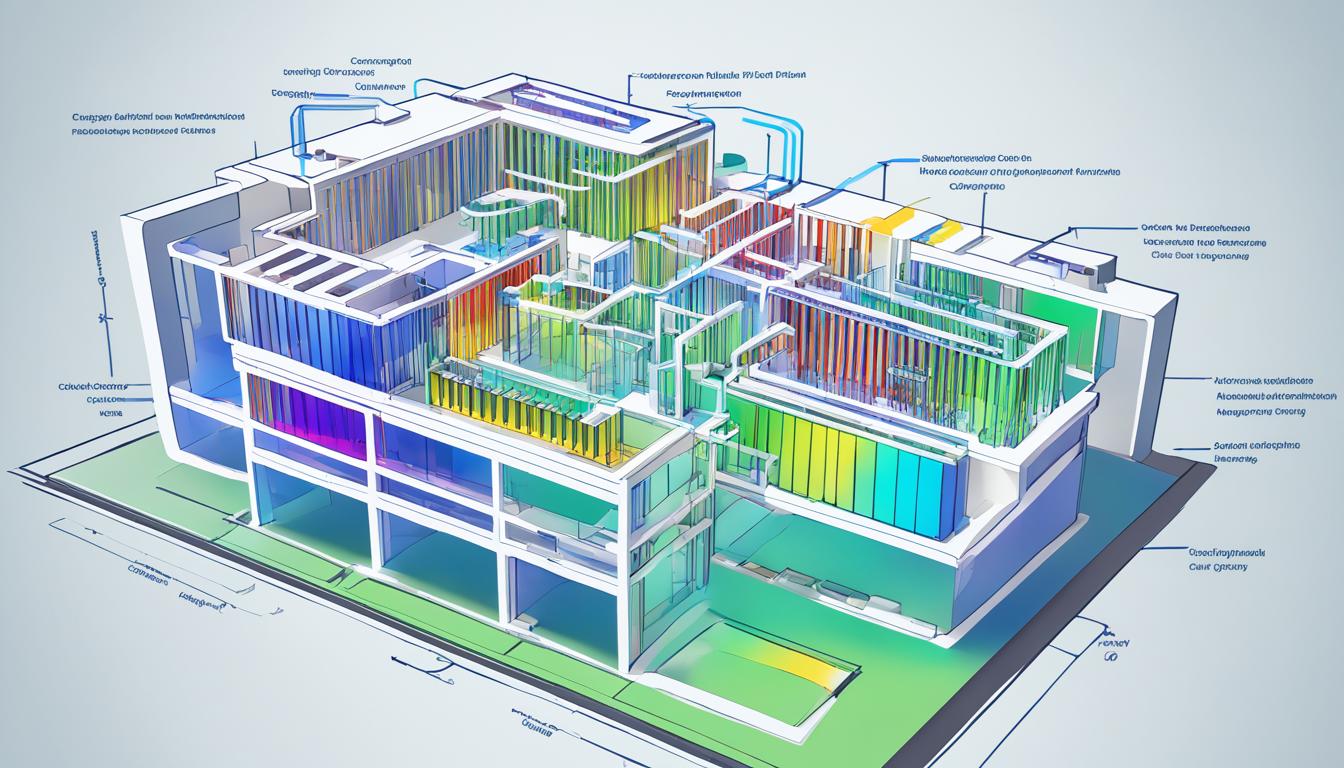Using specialized duct design software helps make sure your HVAC designs follow the rules. These tools make it easier to create systems that meet building codes for all types of buildings.
Duct design software covers important parts of HVAC compliance. It helps with load calculations, duct sizing, and following building codes. With these tools, you get precise drawings and blueprints that match design specs and make installations go smoothly.
Advanced software for HVAC projects ensures buildings have the best air quality, temperature control, and comfort. It’s key for contractors, building owners, and managers. They want to make safe, efficient, and comfortable indoor spaces.
Understanding HVAC Code Requirements
HVAC compliance is key for safe and efficient buildings. It’s important to know the basics of building codes to design systems that follow the law and work well. Let’s look at the main points of HVAC code requirements.
Common HVAC Codes and Standards
HVAC systems must follow many codes and standards. These rules cover heating, ventilation, air conditioning, and saving energy. The International Mechanical Code (IMC) and ASHRAE standards are often used for HVAC rules.
| Code/Standard | Focus Area | Key Requirements |
|---|---|---|
| IMC | General HVAC | Ventilation rates, equipment installation |
| ASHRAE 90.1 | Energy Efficiency | Insulation levels, equipment efficiency |
| NFPA 90A | Fire Safety | Duct materials, fire dampers |
Importance of Code Compliance in HVAC Design
Following building codes makes sure your HVAC system works safely and efficiently. An energy-efficient duct layout cuts down on energy waste and lowers costs. Staying compliant also makes the air cleaner and people more comfortable.
Consequences of Non-Compliance
If you don’t meet HVAC standards, you could face big problems. You might get fines, project delays, or even legal trouble. Non-compliant systems use more energy, don’t last as long, and can be dangerous.
- Fines and penalties
- Increased energy costs
- Shortened equipment lifespan
- Safety hazards
- Legal liability
Introduction to Duct Design Software
Duct design software changes how HVAC pros plan and set up air systems. These tools make making ductwork drawings easier and improve air flow efficiency.
Today’s duct design tools have many features that make hard tasks easier:
- Precise load calculations
- Automated ductwork sizing
- 3D system visualization
- Energy performance analysis
- Code compliance checks
With these tools, you can make detailed drawings for ductwork. They take into account building specs, equipment needs, and airflow. This ensures your HVAC designs work well and follow industry rules.
Improving air distribution is a big plus of duct design software. These tools check your design for any issues and suggest ways to make it better. This can make your system work better and use less energy. It makes indoor spaces more comfortable and can cut down on costs for building owners.
When looking at duct design software, think about how it fits into your work and if it has the features you need. The right tool can really increase your productivity. It helps you make HVAC designs that are top-notch and meet all the codes.
Key Features of Duct Design Software for Code Compliance
Duct design software has powerful tools to make sure your HVAC systems follow the rules. These tools make designing easier and help create ducts that save energy. Let’s look at the main features that make these software tools a must-have for HVAC pros.
Load Calculation Tools
Calculating HVAC loads is the first step in designing a system. Software tools look at the building, how it’s used, and the local weather to figure out what heating and cooling it needs. This makes sure your system has the right size and runs efficiently.
Ductwork Sizing and Layout Capabilities
Getting the ducts the right size is key for a system to work well. Software does this automatically, taking into account airflow, resistance, and space. It creates the best duct layouts that follow the rules for air flow and efficiency.
Energy Analysis Functions
Building codes now focus a lot on saving energy. Duct design software has tools to check how well a system works and how to use less energy. These tools let you test different designs to make sure they follow energy rules.
3D Visualization and Modeling
3D modeling brings HVAC designs to life. It helps spot problems with other building systems and makes sure everything fits right. It’s great for showing inspectors and others that your design meets the rules.
| Feature | Benefits | Code Compliance Impact |
|---|---|---|
| Load Calculation Tools | Accurate system sizing | Meets capacity requirements |
| Duct Sizing | Optimal airflow distribution | Ensures proper ventilation |
| Energy Analysis | Improved system efficiency | Meets energy conservation codes |
| 3D Visualization | Clash detection | Facilitates inspection and approval |
Using these features, you can design HVAC systems that go beyond the minimum requirements. This leads to systems that work better, easier approvals, and buildings that perform well.
Selecting the Right Duct Design Software for Your Projects
Choosing the right HVAC software tools is key to your project’s success. Think about your project’s size, budget, and what you need. This will help you pick the best duct design software.
For big projects, look at integrated design suites. They have everything you need for load calculations, designing ductwork, and checking energy use. If your project is small, consider software that focuses on one area to save money.
| Software Type | Best For | Key Features |
|---|---|---|
| Integrated Design Suites | Large-scale projects | Comprehensive tools, BIM integration |
| Load Calculation Software | Precise HVAC sizing | Heating/cooling load analysis |
| Ductwork Design Software | Detailed duct layouts | Airflow simulations, pressure loss calculations |
| Energy Analysis Software | Efficiency optimization | Energy consumption modeling, cost projections |
| CAD Software | Detailed system drawings | 2D/3D modeling, technical documentation |
When picking HVAC software, look for easy-to-use interfaces, regular updates, and good customer support. Try out different options to see which one works best for your needs.
Step-by-Step Guide: Using Duct Design Software for Code-Compliant HVAC Systems
Duct design software is key in making HVAC systems follow the rules. This guide shows how to use it for HVAC compliance and the best system performance.
Inputting Building Specifications
First, put your building’s details into the software. This means adding dimensions, insulation levels, and where windows are. Getting this right is important for accurate calculations and the right duct size.
Performing Load Calculations
The software then figures out the heating and cooling needs of your building. These numbers tell you how big the system should be and help decide on duct sizes.
Designing Ductwork Layout
Next, create an energy-saving duct layout with the software. It recommends the best duct sizes and paths for good airflow. This is key for following HVAC rules and making the system work well.
Analyzing Energy Efficiency
Look at how your design saves energy. The software runs tests to show where you can make the ducts better for more efficiency.
Generating Compliance Reports
Last, make detailed reports to show your HVAC system follows the rules. These reports are great for giving to authorities and people involved in the project.
| Step | Key Consideration | Impact on HVAC Compliance |
|---|---|---|
| Building Specifications | Accuracy of measurements | Ensures proper system sizing |
| Load Calculations | Consideration of all heat sources | Prevents over or undersizing |
| Ductwork Layout | Optimal routing and sizing | Improves system efficiency |
| Energy Analysis | Identification of inefficiencies | Enhances overall performance |
| Compliance Reporting | Comprehensive documentation | Facilitates approval processes |
By following these steps, you can use duct design software to make HVAC systems that meet the rules. They will also work better and use less energy.
Common Pitfalls in HVAC Design and How Software Can Help Avoid Them
HVAC design can be tricky, with many common mistakes leading to inefficient systems and not following building codes. Let’s look at these issues and how duct design software can help you avoid them.

One big problem is undersized ducts. This means poor airflow, more energy use, and uncomfortable spaces. Duct design software offers tools for accurate sizing, making sure your system works well and follows the rules.
Another issue is not having enough return air. Without it, your HVAC system can’t work right. Software helps design balanced systems by figuring out the right size and place for return air vents and ducts.
Also, getting load calculations wrong can lead to using too much or too little equipment. This wastes energy and money. HVAC design software has tools for precise load calculations, considering things like building materials, how many people will use it, and the local climate.
- Duct leakage
- Poor zoning
- Inadequate ventilation
- Incorrect equipment selection
These problems can be fixed with comprehensive duct design software. By using building codes in their algorithms, these programs make sure your designs meet all the standards from the start. This saves time, cuts down on mistakes, and helps you make more efficient, rule-following HVAC systems.
Integrating Duct Design Software with BIM for Comprehensive Compliance
Using HVAC software tools with Building Information Modeling (BIM) makes a strong system for following building codes. This mix lets you see your HVAC design with the whole building, making coordination better and reducing conflicts.
BIM tools like Revit or ArchiCAD work well with duct design software. This team-up helps find issues early, like ductwork hitting structural parts or other systems. Finding these problems early saves time and money during building.
This integration also makes load calculations more accurate. BIM models give detailed info on building materials, orientation, and things that affect HVAC performance. This info goes right into your duct design software, leading to better system sizing and layout.
| Benefits of Integrating Duct Design Software with BIM | Impact on Code Compliance |
|---|---|
| Improved clash detection | Ensures proper clearances and access for maintenance |
| More accurate load calculations | Helps meet energy efficiency requirements |
| Better visualization of systems | Facilitates easier inspections and approvals |
| Streamlined documentation | Simplifies submission of compliance reports |
By using this approach, you can make HVAC designs that go beyond building code rules. BIM’s detailed view and duct design software’s special features ensure your projects are up to code, efficient, and save money.
Case Studies: Successful HVAC Designs Using Duct Design Software
Duct design software has changed the game in HVAC compliance and energy-efficient duct layouts. Let’s look at real examples that show how this tech boosts ventilation system design.
Residential Project Example
A custom home in Denver used duct design software to make the most of a 3.5-ton HVAC system. The software helped figure out the right duct sizes for the 2,500 sq ft space. This led to a 15% boost in energy efficiency and even temperatures in every room.

Commercial Building Case Study
An office complex in Atlanta had to meet tough energy codes. The team used software to design an energy-efficient duct layout. This cut pressure loss by 20%. It meant smaller equipment and a 25% drop in energy use, beating local HVAC standards.
Industrial Facility Implementation
A manufacturing plant in Texas needed a top-notch ventilation system to handle heat and air quality. Engineers used duct design software to create a layout that boosted air circulation by 30% and cut ductwork material by 18%. The outcome was a system that met tough industrial standards and lowered costs.
| Project Type | Energy Savings | Compliance Achievement |
|---|---|---|
| Residential | 15% increase | Perfect temperature balance |
| Commercial | 25% decrease | Exceeded local standards |
| Industrial | 30% air circulation improvement | Met rigorous industrial codes |
These examples show how duct design software helps with HVAC compliance across different projects, from homes to factories. By using this tech, you can make sure your designs follow or beat the rules and save energy.
How to Ensure HVAC Designs Meet Code Requirements Using Duct Design Software
Duct design software changes the game for HVAC compliance. It helps streamline your design process and ensures you follow building code rules. Let’s see how to use this technology well.
Begin by adding the right building details into your software. This means dimensions, materials, and how many people will use the space. The software then does load calculations based on ASHRAE rules. This gives you a strong base for your HVAC design.
Then, use the software to plan out your ductwork. Make sure your air distribution system meets code for airflow and pressure. The 3D visualization tool lets you find problems early, saving time and money.
Energy analysis is key for HVAC compliance. These tools check if your design is energy-efficient. They make sure it meets or beats the efficiency standards of local building codes.
| Software Feature | Compliance Benefit |
|---|---|
| Load Calculation | Meets ASHRAE standards |
| Ductwork Sizing | Ensures proper airflow |
| Energy Analysis | Verifies efficiency standards |
| 3D Visualization | Identifies potential code violations |
Finally, create detailed compliance reports. These show your design follows building code rules, making approval easier. By following these steps, you’ll make HVAC designs that go beyond what’s required.
Future Trends in HVAC Design Software and Code Compliance
The future of HVAC software tools is changing fast, with new advancements coming up. It’s important to know about these trends for your next HVAC project.
One big change is the use of Internet of Things (IoT) devices with HVAC design software. This lets you monitor and adjust HVAC systems in real-time. It makes them more energy-efficient and keeps people more comfortable.
Artificial Intelligence (AI) is also changing HVAC design. AI can predict when equipment might break down and schedule maintenance early. This cuts down on repair time and costs.
Creating energy-efficient duct layouts is becoming more important as building codes get stricter on sustainability. New HVAC design software has tools for detailed energy analysis. These tools help you make layouts that are efficient and meet tough code standards.
| Trend | Impact on HVAC Design | Benefits |
|---|---|---|
| IoT Integration | Real-time system monitoring | Improved energy efficiency |
| AI-driven Maintenance | Predictive equipment care | Reduced downtime and costs |
| Advanced Energy Analysis | Optimized duct layouts | Enhanced sustainability compliance |
As building codes change, HVAC software tools are getting better at helping with compliance. These tools make it easier to follow complex rules. They help ensure your designs meet or beat the standards, making the approval process smoother for your projects.
Best Practices for Maintaining Code Compliance Throughout the HVAC Lifecycle
Keeping your HVAC system up to code is an ongoing task. It’s not just about the start. You must keep an eye on it throughout its life to follow building code rules.
Regular Software Updates
HVAC software tools help you stay compliant. Always update your duct design software. These updates bring the latest code changes, keeping you in line with laws.
Remember to check for updates every month. This ensures you’re using the newest version.
Ongoing Training and Education
The HVAC field changes fast. You and your team should keep learning. Go to workshops, webinars, and conferences on HVAC compliance and building codes.
This knowledge lets you use HVAC software better and understand codes well.
Collaboration with Code Officials
Get to know local code officials. They know about upcoming changes in building codes. Ask them to look at your designs early.
This helps avoid compliance issues before they start, saving time and money.





0 Comments